Analysis of Nurse Prescribing Roles and Patient Outcomes in Healthcare
VerifiedAdded on 2020/04/21
|6
|1946
|69
Report
AI Summary
This report analyzes the study by Jones et al. (2011) which explored nurse prescribing roles in acute care settings. The research, conducted in an English hospital, used a mixed-method approach involving interviews, observations, and surveys to assess the impact of nurse prescribing on patient outcomes and team dynamics. The findings revealed that nurse prescribing was perceived to benefit patients and enhance teamwork, with no significant differences found between nurses and doctors in prescribing performance. However, patients reported higher satisfaction with medication-related information from nurse prescribers. The study's limitations include a non-generalizable sample and potential researcher bias. The report emphasizes the importance of further research to assess the influence of nurse prescribing on care delivery and suggests that healthcare settings should consider increasing operational and supportive infrastructures to support nurse prescribing practices. Ethical considerations and policy implications are also discussed, highlighting the need for continued evaluation and policy reforms to optimize nurse prescribing roles.
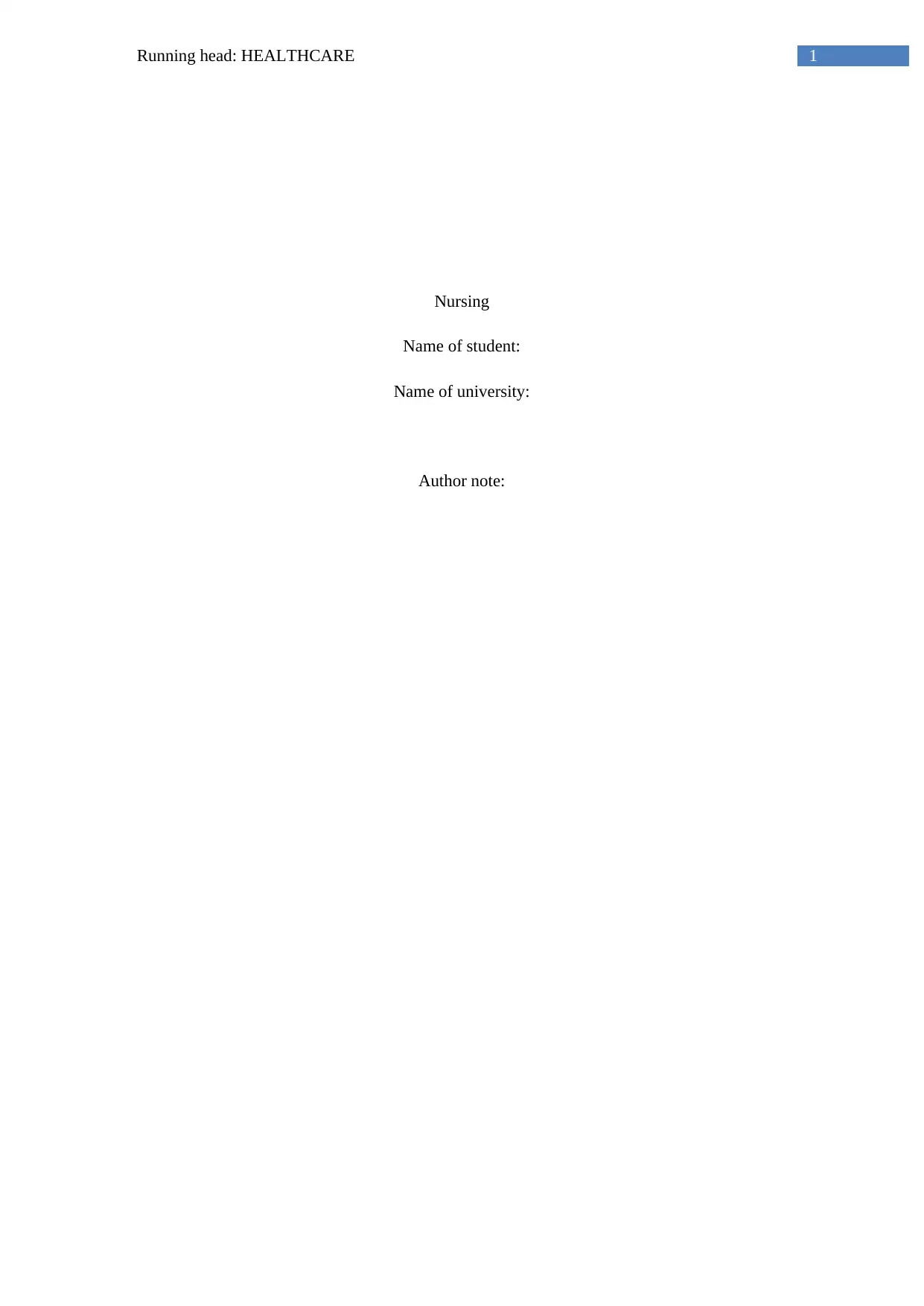
1Running head: HEALTHCARE
Nursing
Name of student:
Name of university:
Author note:
Nursing
Name of student:
Name of university:
Author note:
Paraphrase This Document
Need a fresh take? Get an instant paraphrase of this document with our AI Paraphraser
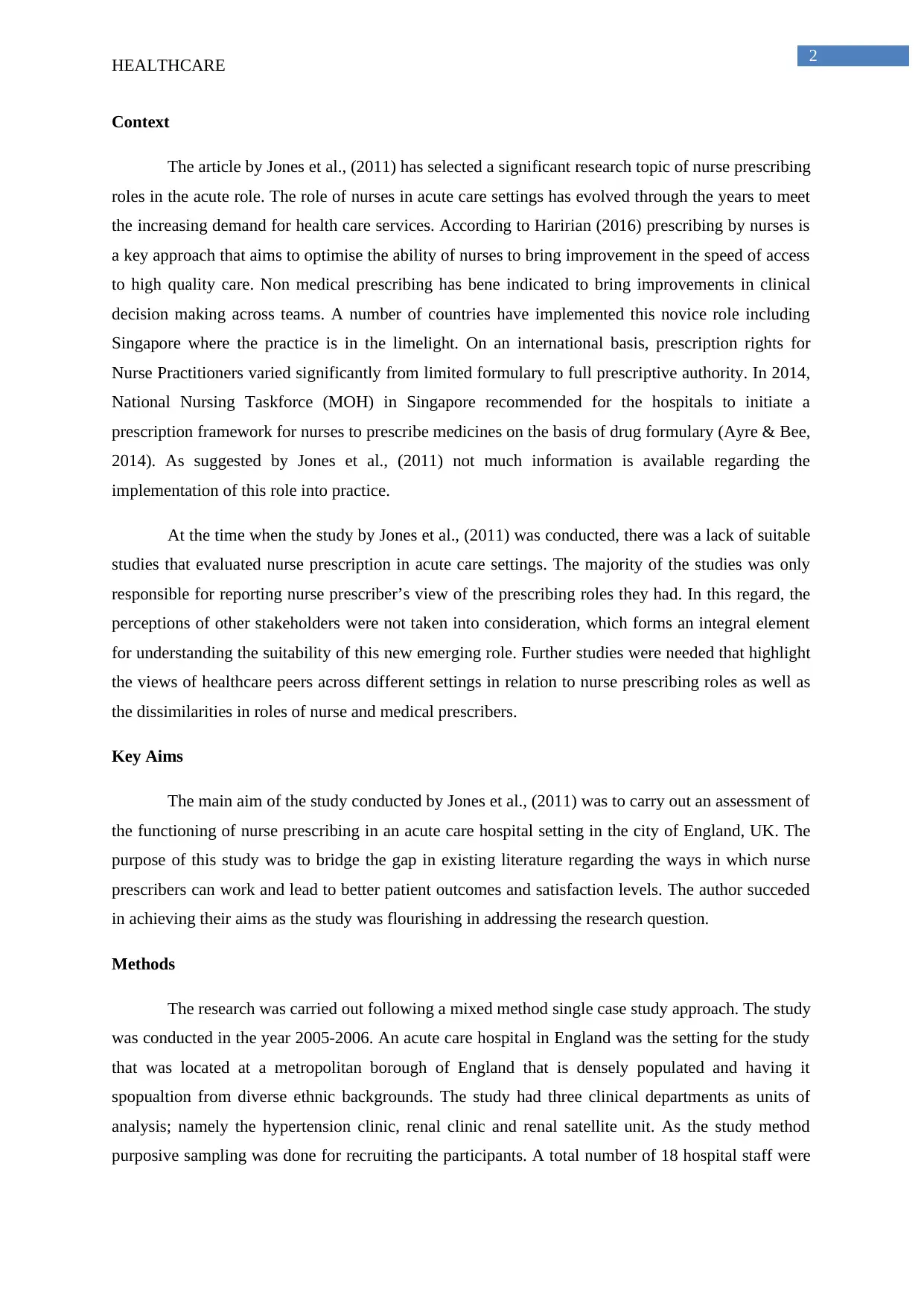
2
HEALTHCARE
Context
The article by Jones et al., (2011) has selected a significant research topic of nurse prescribing
roles in the acute role. The role of nurses in acute care settings has evolved through the years to meet
the increasing demand for health care services. According to Haririan (2016) prescribing by nurses is
a key approach that aims to optimise the ability of nurses to bring improvement in the speed of access
to high quality care. Non medical prescribing has bene indicated to bring improvements in clinical
decision making across teams. A number of countries have implemented this novice role including
Singapore where the practice is in the limelight. On an international basis, prescription rights for
Nurse Practitioners varied significantly from limited formulary to full prescriptive authority. In 2014,
National Nursing Taskforce (MOH) in Singapore recommended for the hospitals to initiate a
prescription framework for nurses to prescribe medicines on the basis of drug formulary (Ayre & Bee,
2014). As suggested by Jones et al., (2011) not much information is available regarding the
implementation of this role into practice.
At the time when the study by Jones et al., (2011) was conducted, there was a lack of suitable
studies that evaluated nurse prescription in acute care settings. The majority of the studies was only
responsible for reporting nurse prescriber’s view of the prescribing roles they had. In this regard, the
perceptions of other stakeholders were not taken into consideration, which forms an integral element
for understanding the suitability of this new emerging role. Further studies were needed that highlight
the views of healthcare peers across different settings in relation to nurse prescribing roles as well as
the dissimilarities in roles of nurse and medical prescribers.
Key Aims
The main aim of the study conducted by Jones et al., (2011) was to carry out an assessment of
the functioning of nurse prescribing in an acute care hospital setting in the city of England, UK. The
purpose of this study was to bridge the gap in existing literature regarding the ways in which nurse
prescribers can work and lead to better patient outcomes and satisfaction levels. The author succeded
in achieving their aims as the study was flourishing in addressing the research question.
Methods
The research was carried out following a mixed method single case study approach. The study
was conducted in the year 2005-2006. An acute care hospital in England was the setting for the study
that was located at a metropolitan borough of England that is densely populated and having it
spopualtion from diverse ethnic backgrounds. The study had three clinical departments as units of
analysis; namely the hypertension clinic, renal clinic and renal satellite unit. As the study method
purposive sampling was done for recruiting the participants. A total number of 18 hospital staff were
HEALTHCARE
Context
The article by Jones et al., (2011) has selected a significant research topic of nurse prescribing
roles in the acute role. The role of nurses in acute care settings has evolved through the years to meet
the increasing demand for health care services. According to Haririan (2016) prescribing by nurses is
a key approach that aims to optimise the ability of nurses to bring improvement in the speed of access
to high quality care. Non medical prescribing has bene indicated to bring improvements in clinical
decision making across teams. A number of countries have implemented this novice role including
Singapore where the practice is in the limelight. On an international basis, prescription rights for
Nurse Practitioners varied significantly from limited formulary to full prescriptive authority. In 2014,
National Nursing Taskforce (MOH) in Singapore recommended for the hospitals to initiate a
prescription framework for nurses to prescribe medicines on the basis of drug formulary (Ayre & Bee,
2014). As suggested by Jones et al., (2011) not much information is available regarding the
implementation of this role into practice.
At the time when the study by Jones et al., (2011) was conducted, there was a lack of suitable
studies that evaluated nurse prescription in acute care settings. The majority of the studies was only
responsible for reporting nurse prescriber’s view of the prescribing roles they had. In this regard, the
perceptions of other stakeholders were not taken into consideration, which forms an integral element
for understanding the suitability of this new emerging role. Further studies were needed that highlight
the views of healthcare peers across different settings in relation to nurse prescribing roles as well as
the dissimilarities in roles of nurse and medical prescribers.
Key Aims
The main aim of the study conducted by Jones et al., (2011) was to carry out an assessment of
the functioning of nurse prescribing in an acute care hospital setting in the city of England, UK. The
purpose of this study was to bridge the gap in existing literature regarding the ways in which nurse
prescribers can work and lead to better patient outcomes and satisfaction levels. The author succeded
in achieving their aims as the study was flourishing in addressing the research question.
Methods
The research was carried out following a mixed method single case study approach. The study
was conducted in the year 2005-2006. An acute care hospital in England was the setting for the study
that was located at a metropolitan borough of England that is densely populated and having it
spopualtion from diverse ethnic backgrounds. The study had three clinical departments as units of
analysis; namely the hypertension clinic, renal clinic and renal satellite unit. As the study method
purposive sampling was done for recruiting the participants. A total number of 18 hospital staff were
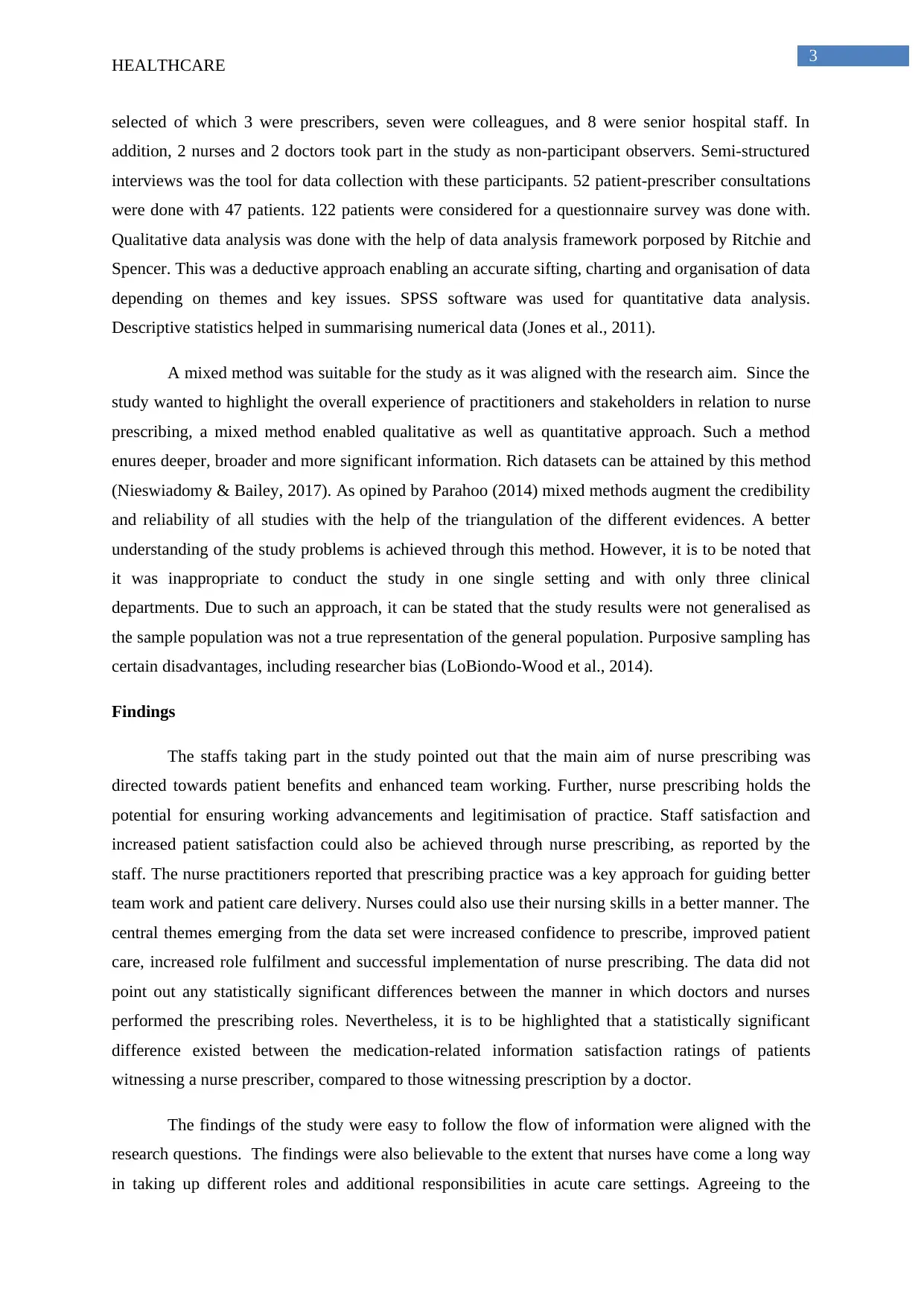
3
HEALTHCARE
selected of which 3 were prescribers, seven were colleagues, and 8 were senior hospital staff. In
addition, 2 nurses and 2 doctors took part in the study as non-participant observers. Semi-structured
interviews was the tool for data collection with these participants. 52 patient-prescriber consultations
were done with 47 patients. 122 patients were considered for a questionnaire survey was done with.
Qualitative data analysis was done with the help of data analysis framework porposed by Ritchie and
Spencer. This was a deductive approach enabling an accurate sifting, charting and organisation of data
depending on themes and key issues. SPSS software was used for quantitative data analysis.
Descriptive statistics helped in summarising numerical data (Jones et al., 2011).
A mixed method was suitable for the study as it was aligned with the research aim. Since the
study wanted to highlight the overall experience of practitioners and stakeholders in relation to nurse
prescribing, a mixed method enabled qualitative as well as quantitative approach. Such a method
enures deeper, broader and more significant information. Rich datasets can be attained by this method
(Nieswiadomy & Bailey, 2017). As opined by Parahoo (2014) mixed methods augment the credibility
and reliability of all studies with the help of the triangulation of the different evidences. A better
understanding of the study problems is achieved through this method. However, it is to be noted that
it was inappropriate to conduct the study in one single setting and with only three clinical
departments. Due to such an approach, it can be stated that the study results were not generalised as
the sample population was not a true representation of the general population. Purposive sampling has
certain disadvantages, including researcher bias (LoBiondo-Wood et al., 2014).
Findings
The staffs taking part in the study pointed out that the main aim of nurse prescribing was
directed towards patient benefits and enhanced team working. Further, nurse prescribing holds the
potential for ensuring working advancements and legitimisation of practice. Staff satisfaction and
increased patient satisfaction could also be achieved through nurse prescribing, as reported by the
staff. The nurse practitioners reported that prescribing practice was a key approach for guiding better
team work and patient care delivery. Nurses could also use their nursing skills in a better manner. The
central themes emerging from the data set were increased confidence to prescribe, improved patient
care, increased role fulfilment and successful implementation of nurse prescribing. The data did not
point out any statistically significant differences between the manner in which doctors and nurses
performed the prescribing roles. Nevertheless, it is to be highlighted that a statistically significant
difference existed between the medication-related information satisfaction ratings of patients
witnessing a nurse prescriber, compared to those witnessing prescription by a doctor.
The findings of the study were easy to follow the flow of information were aligned with the
research questions. The findings were also believable to the extent that nurses have come a long way
in taking up different roles and additional responsibilities in acute care settings. Agreeing to the
HEALTHCARE
selected of which 3 were prescribers, seven were colleagues, and 8 were senior hospital staff. In
addition, 2 nurses and 2 doctors took part in the study as non-participant observers. Semi-structured
interviews was the tool for data collection with these participants. 52 patient-prescriber consultations
were done with 47 patients. 122 patients were considered for a questionnaire survey was done with.
Qualitative data analysis was done with the help of data analysis framework porposed by Ritchie and
Spencer. This was a deductive approach enabling an accurate sifting, charting and organisation of data
depending on themes and key issues. SPSS software was used for quantitative data analysis.
Descriptive statistics helped in summarising numerical data (Jones et al., 2011).
A mixed method was suitable for the study as it was aligned with the research aim. Since the
study wanted to highlight the overall experience of practitioners and stakeholders in relation to nurse
prescribing, a mixed method enabled qualitative as well as quantitative approach. Such a method
enures deeper, broader and more significant information. Rich datasets can be attained by this method
(Nieswiadomy & Bailey, 2017). As opined by Parahoo (2014) mixed methods augment the credibility
and reliability of all studies with the help of the triangulation of the different evidences. A better
understanding of the study problems is achieved through this method. However, it is to be noted that
it was inappropriate to conduct the study in one single setting and with only three clinical
departments. Due to such an approach, it can be stated that the study results were not generalised as
the sample population was not a true representation of the general population. Purposive sampling has
certain disadvantages, including researcher bias (LoBiondo-Wood et al., 2014).
Findings
The staffs taking part in the study pointed out that the main aim of nurse prescribing was
directed towards patient benefits and enhanced team working. Further, nurse prescribing holds the
potential for ensuring working advancements and legitimisation of practice. Staff satisfaction and
increased patient satisfaction could also be achieved through nurse prescribing, as reported by the
staff. The nurse practitioners reported that prescribing practice was a key approach for guiding better
team work and patient care delivery. Nurses could also use their nursing skills in a better manner. The
central themes emerging from the data set were increased confidence to prescribe, improved patient
care, increased role fulfilment and successful implementation of nurse prescribing. The data did not
point out any statistically significant differences between the manner in which doctors and nurses
performed the prescribing roles. Nevertheless, it is to be highlighted that a statistically significant
difference existed between the medication-related information satisfaction ratings of patients
witnessing a nurse prescriber, compared to those witnessing prescription by a doctor.
The findings of the study were easy to follow the flow of information were aligned with the
research questions. The findings were also believable to the extent that nurses have come a long way
in taking up different roles and additional responsibilities in acute care settings. Agreeing to the
⊘ This is a preview!⊘
Do you want full access?
Subscribe today to unlock all pages.

Trusted by 1+ million students worldwide
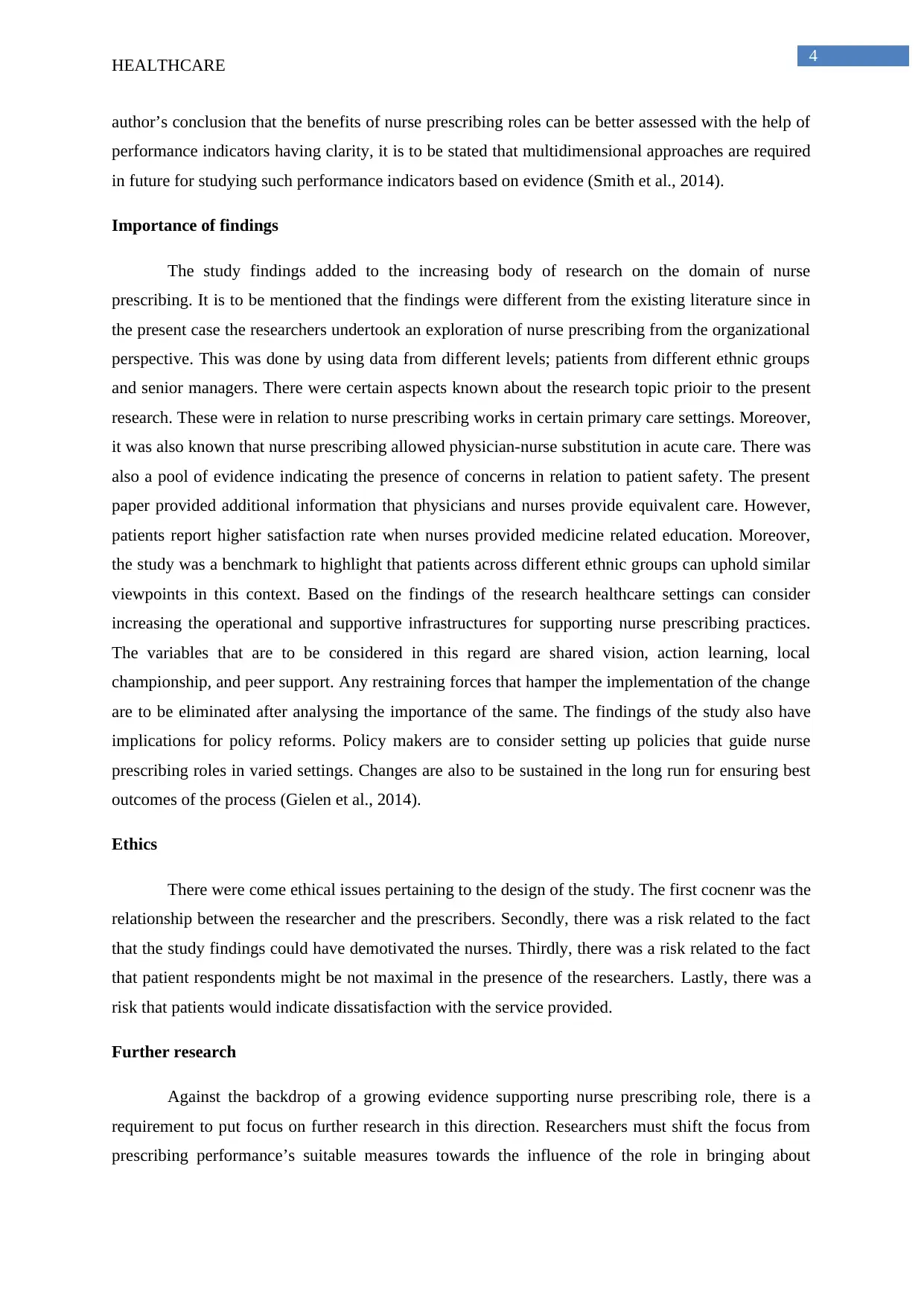
4
HEALTHCARE
author’s conclusion that the benefits of nurse prescribing roles can be better assessed with the help of
performance indicators having clarity, it is to be stated that multidimensional approaches are required
in future for studying such performance indicators based on evidence (Smith et al., 2014).
Importance of findings
The study findings added to the increasing body of research on the domain of nurse
prescribing. It is to be mentioned that the findings were different from the existing literature since in
the present case the researchers undertook an exploration of nurse prescribing from the organizational
perspective. This was done by using data from different levels; patients from different ethnic groups
and senior managers. There were certain aspects known about the research topic prioir to the present
research. These were in relation to nurse prescribing works in certain primary care settings. Moreover,
it was also known that nurse prescribing allowed physician-nurse substitution in acute care. There was
also a pool of evidence indicating the presence of concerns in relation to patient safety. The present
paper provided additional information that physicians and nurses provide equivalent care. However,
patients report higher satisfaction rate when nurses provided medicine related education. Moreover,
the study was a benchmark to highlight that patients across different ethnic groups can uphold similar
viewpoints in this context. Based on the findings of the research healthcare settings can consider
increasing the operational and supportive infrastructures for supporting nurse prescribing practices.
The variables that are to be considered in this regard are shared vision, action learning, local
championship, and peer support. Any restraining forces that hamper the implementation of the change
are to be eliminated after analysing the importance of the same. The findings of the study also have
implications for policy reforms. Policy makers are to consider setting up policies that guide nurse
prescribing roles in varied settings. Changes are also to be sustained in the long run for ensuring best
outcomes of the process (Gielen et al., 2014).
Ethics
There were come ethical issues pertaining to the design of the study. The first cocnenr was the
relationship between the researcher and the prescribers. Secondly, there was a risk related to the fact
that the study findings could have demotivated the nurses. Thirdly, there was a risk related to the fact
that patient respondents might be not maximal in the presence of the researchers. Lastly, there was a
risk that patients would indicate dissatisfaction with the service provided.
Further research
Against the backdrop of a growing evidence supporting nurse prescribing role, there is a
requirement to put focus on further research in this direction. Researchers must shift the focus from
prescribing performance’s suitable measures towards the influence of the role in bringing about
HEALTHCARE
author’s conclusion that the benefits of nurse prescribing roles can be better assessed with the help of
performance indicators having clarity, it is to be stated that multidimensional approaches are required
in future for studying such performance indicators based on evidence (Smith et al., 2014).
Importance of findings
The study findings added to the increasing body of research on the domain of nurse
prescribing. It is to be mentioned that the findings were different from the existing literature since in
the present case the researchers undertook an exploration of nurse prescribing from the organizational
perspective. This was done by using data from different levels; patients from different ethnic groups
and senior managers. There were certain aspects known about the research topic prioir to the present
research. These were in relation to nurse prescribing works in certain primary care settings. Moreover,
it was also known that nurse prescribing allowed physician-nurse substitution in acute care. There was
also a pool of evidence indicating the presence of concerns in relation to patient safety. The present
paper provided additional information that physicians and nurses provide equivalent care. However,
patients report higher satisfaction rate when nurses provided medicine related education. Moreover,
the study was a benchmark to highlight that patients across different ethnic groups can uphold similar
viewpoints in this context. Based on the findings of the research healthcare settings can consider
increasing the operational and supportive infrastructures for supporting nurse prescribing practices.
The variables that are to be considered in this regard are shared vision, action learning, local
championship, and peer support. Any restraining forces that hamper the implementation of the change
are to be eliminated after analysing the importance of the same. The findings of the study also have
implications for policy reforms. Policy makers are to consider setting up policies that guide nurse
prescribing roles in varied settings. Changes are also to be sustained in the long run for ensuring best
outcomes of the process (Gielen et al., 2014).
Ethics
There were come ethical issues pertaining to the design of the study. The first cocnenr was the
relationship between the researcher and the prescribers. Secondly, there was a risk related to the fact
that the study findings could have demotivated the nurses. Thirdly, there was a risk related to the fact
that patient respondents might be not maximal in the presence of the researchers. Lastly, there was a
risk that patients would indicate dissatisfaction with the service provided.
Further research
Against the backdrop of a growing evidence supporting nurse prescribing role, there is a
requirement to put focus on further research in this direction. Researchers must shift the focus from
prescribing performance’s suitable measures towards the influence of the role in bringing about
Paraphrase This Document
Need a fresh take? Get an instant paraphrase of this document with our AI Paraphraser
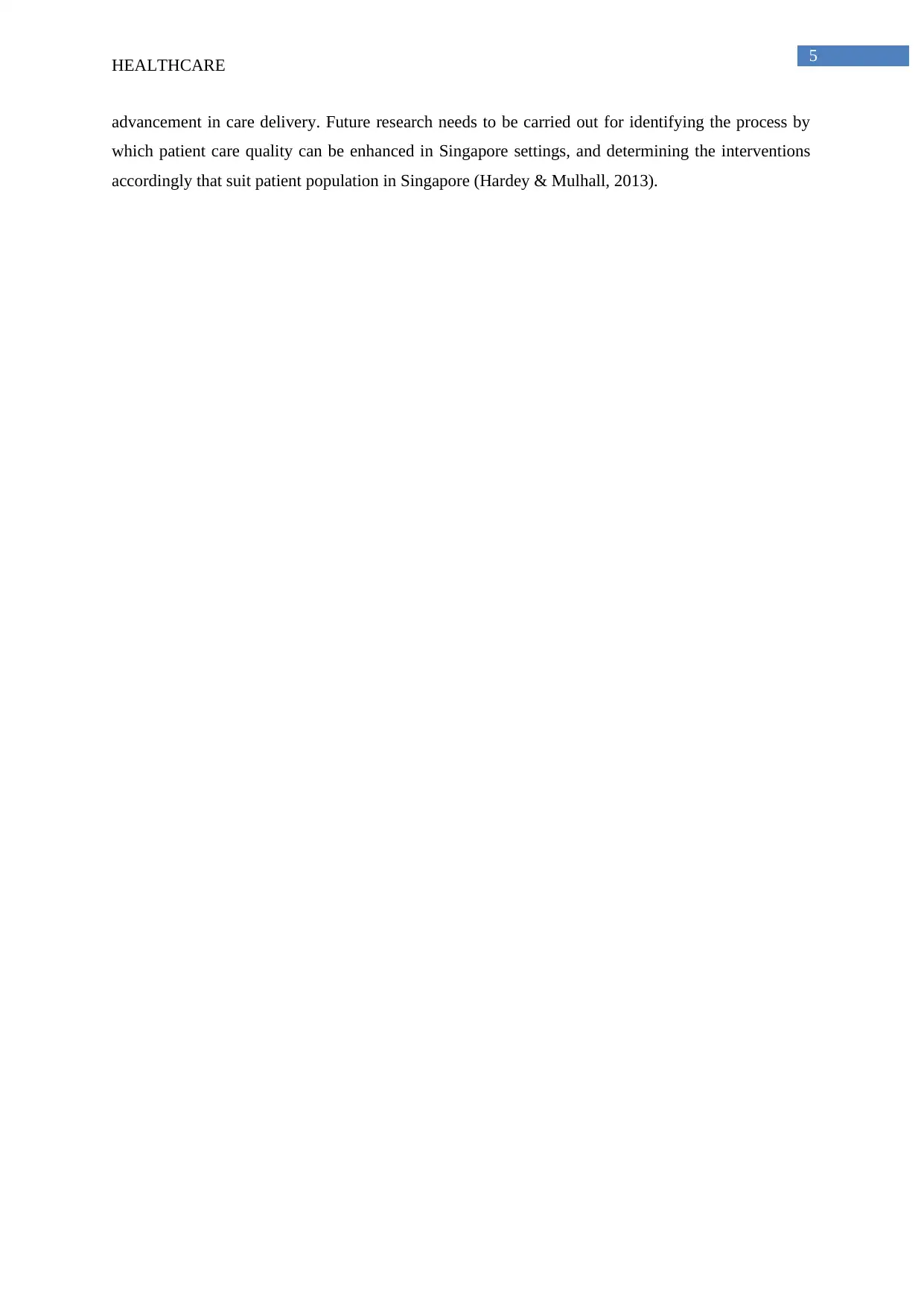
5
HEALTHCARE
advancement in care delivery. Future research needs to be carried out for identifying the process by
which patient care quality can be enhanced in Singapore settings, and determining the interventions
accordingly that suit patient population in Singapore (Hardey & Mulhall, 2013).
HEALTHCARE
advancement in care delivery. Future research needs to be carried out for identifying the process by
which patient care quality can be enhanced in Singapore settings, and determining the interventions
accordingly that suit patient population in Singapore (Hardey & Mulhall, 2013).
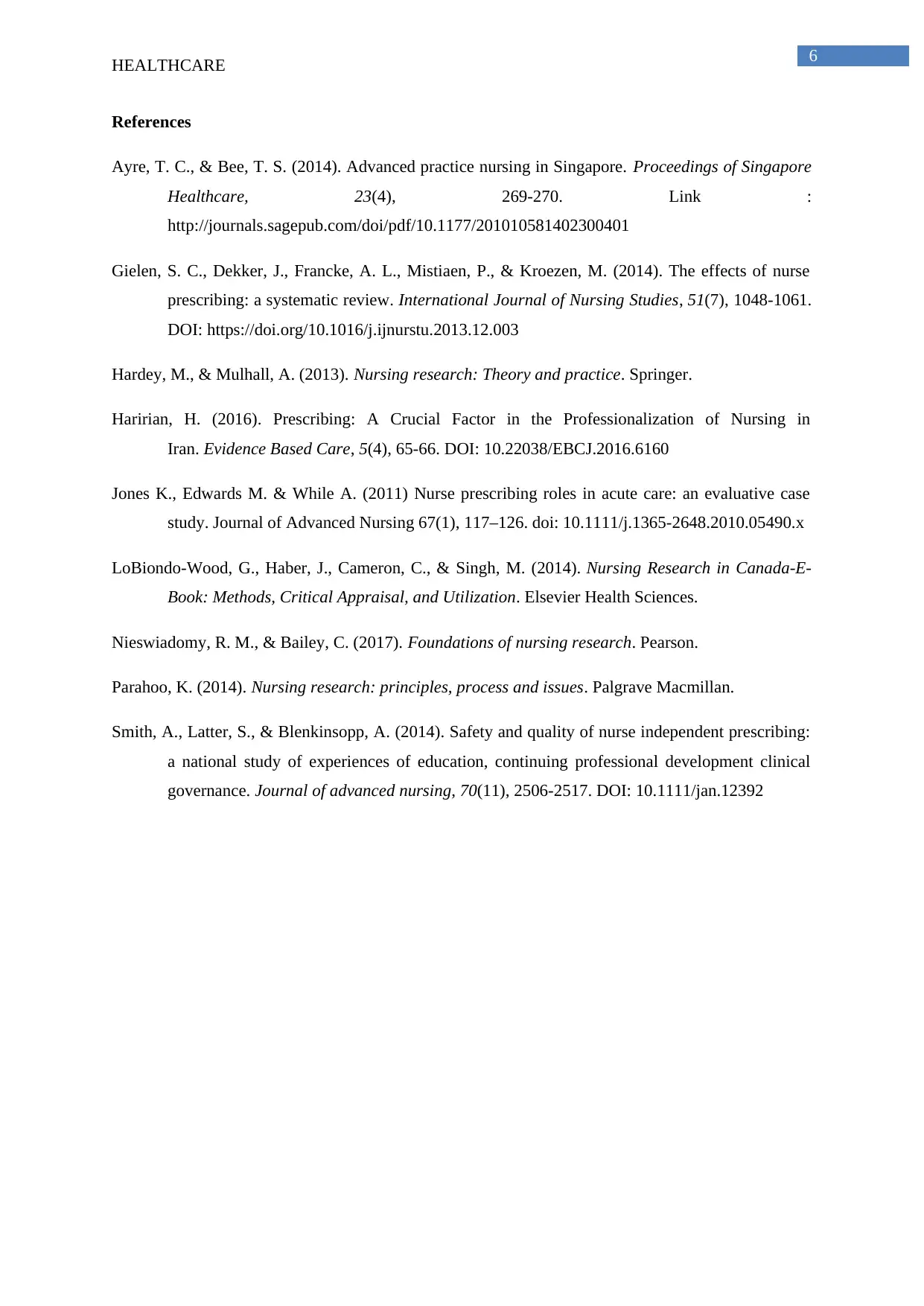
6
HEALTHCARE
References
Ayre, T. C., & Bee, T. S. (2014). Advanced practice nursing in Singapore. Proceedings of Singapore
Healthcare, 23(4), 269-270. Link :
http://journals.sagepub.com/doi/pdf/10.1177/201010581402300401
Gielen, S. C., Dekker, J., Francke, A. L., Mistiaen, P., & Kroezen, M. (2014). The effects of nurse
prescribing: a systematic review. International Journal of Nursing Studies, 51(7), 1048-1061.
DOI: https://doi.org/10.1016/j.ijnurstu.2013.12.003
Hardey, M., & Mulhall, A. (2013). Nursing research: Theory and practice. Springer.
Haririan, H. (2016). Prescribing: A Crucial Factor in the Professionalization of Nursing in
Iran. Evidence Based Care, 5(4), 65-66. DOI: 10.22038/EBCJ.2016.6160
Jones K., Edwards M. & While A. (2011) Nurse prescribing roles in acute care: an evaluative case
study. Journal of Advanced Nursing 67(1), 117–126. doi: 10.1111/j.1365-2648.2010.05490.x
LoBiondo-Wood, G., Haber, J., Cameron, C., & Singh, M. (2014). Nursing Research in Canada-E-
Book: Methods, Critical Appraisal, and Utilization. Elsevier Health Sciences.
Nieswiadomy, R. M., & Bailey, C. (2017). Foundations of nursing research. Pearson.
Parahoo, K. (2014). Nursing research: principles, process and issues. Palgrave Macmillan.
Smith, A., Latter, S., & Blenkinsopp, A. (2014). Safety and quality of nurse independent prescribing:
a national study of experiences of education, continuing professional development clinical
governance. Journal of advanced nursing, 70(11), 2506-2517. DOI: 10.1111/jan.12392
HEALTHCARE
References
Ayre, T. C., & Bee, T. S. (2014). Advanced practice nursing in Singapore. Proceedings of Singapore
Healthcare, 23(4), 269-270. Link :
http://journals.sagepub.com/doi/pdf/10.1177/201010581402300401
Gielen, S. C., Dekker, J., Francke, A. L., Mistiaen, P., & Kroezen, M. (2014). The effects of nurse
prescribing: a systematic review. International Journal of Nursing Studies, 51(7), 1048-1061.
DOI: https://doi.org/10.1016/j.ijnurstu.2013.12.003
Hardey, M., & Mulhall, A. (2013). Nursing research: Theory and practice. Springer.
Haririan, H. (2016). Prescribing: A Crucial Factor in the Professionalization of Nursing in
Iran. Evidence Based Care, 5(4), 65-66. DOI: 10.22038/EBCJ.2016.6160
Jones K., Edwards M. & While A. (2011) Nurse prescribing roles in acute care: an evaluative case
study. Journal of Advanced Nursing 67(1), 117–126. doi: 10.1111/j.1365-2648.2010.05490.x
LoBiondo-Wood, G., Haber, J., Cameron, C., & Singh, M. (2014). Nursing Research in Canada-E-
Book: Methods, Critical Appraisal, and Utilization. Elsevier Health Sciences.
Nieswiadomy, R. M., & Bailey, C. (2017). Foundations of nursing research. Pearson.
Parahoo, K. (2014). Nursing research: principles, process and issues. Palgrave Macmillan.
Smith, A., Latter, S., & Blenkinsopp, A. (2014). Safety and quality of nurse independent prescribing:
a national study of experiences of education, continuing professional development clinical
governance. Journal of advanced nursing, 70(11), 2506-2517. DOI: 10.1111/jan.12392
⊘ This is a preview!⊘
Do you want full access?
Subscribe today to unlock all pages.

Trusted by 1+ million students worldwide
1 out of 6
Related Documents
Your All-in-One AI-Powered Toolkit for Academic Success.
+13062052269
info@desklib.com
Available 24*7 on WhatsApp / Email
![[object Object]](/_next/static/media/star-bottom.7253800d.svg)
Unlock your academic potential
Copyright © 2020–2025 A2Z Services. All Rights Reserved. Developed and managed by ZUCOL.





